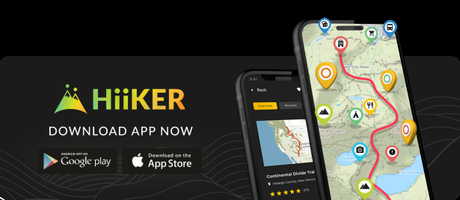This blog is designed to help you discover and learn basic information about the 14er peaks in Colorado. Below is a table of contents where you can skip directly to a specific peak. Each mountain is accompanied by a link to a trail on HiiKER. There may be several known routes up these peaks, many of which are also on HiiKER.
- Introduction
- The 14ers of Colorado: What You Need to Know
- Quandary Peak
- Mount Lincoln
- Mount Bross
- Mount Democrat
- Cameron Peak
- Mount Elbert
- Mount Massive
- La Plata Peak
- Huron Peak
- Missouri Mountain
- Mount of the Holy Cross
- Mount Belford
- Mount Oxford
- Conundrum Peak
- Pyramid Peak
- Maroon Peak
- North Maroon Peak
- Capitol Peak
- Snowmass Mountain
- Castle peak
- Longs Peak
- Mount Evans
- Mount Bierstadt
- Pikes Peak
- Mount Wilson
- El Diente Peak
- Mount Sneffels
- Wilson Peak
- Windom Peak
- Handies Peak
- Redcloud Peak
- Sunshine Peak
- Uncompahgre Peak
- Wetterhorn Peak
- San Luis Peak
- Kit Carson Peak
- Challenger Point
- Humboldt Peak
- Crestone Peak
- Crestone Needle
- Mount Lindsey
- Ellingwood Point
- Blanca Peak
- Little Bear Peak
- Culebra Peak
- Mount Shavano
- Tabeguache Peak
- Antero Peak
- Mount Sherman
- Quandary Peak
- Mount Harvard
- Mount Yale
- Mount Columbia
- Planning Your 14er climbs
- What to Bring
- Climbing the Colorado 14er peaks
- Here are some further ways to prevent altitude sickness:
- Other useful links
Introduction
For those seeking an adventure in the great outdoors, hiking the 14ers (or Fourteeners) of Colorado should be at the top of your list. These towering peaks, each over 14,000 feet above sea level, offer breathtaking views and an unforgettable experience for those who dare to tackle them. Whether you’re a seasoned hiker or just starting out, this guide will help you make the most of your journey to the top of the Rockies. The 14ers of Colorado are a true test of one’s hiking skills and provide a chance to explore the beauty of the state in a unique and challenging way. So pack your bags, lace up your hiking shoes, and get ready for an adventure of a lifetime!
The 14ers of Colorado: What You Need to Know
The 14ers of Colorado are not for the faint of heart and require proper preparation and planning. There are a total of 54 peaks that reach over 14,000 feet, and each one offers its own set of challenges. Before embarking on your journey, it is important to be in good physical condition and to have a good understanding of what you’re getting into.
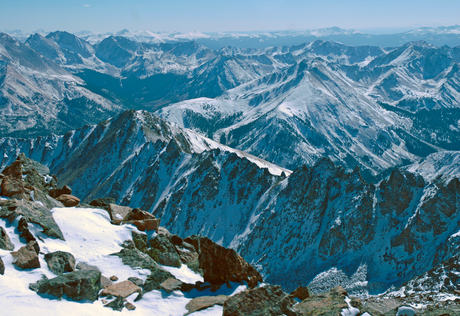
Hiking the 14ers can be a strenuous activity, and you need to be prepared for the physical demands of the trail. Additionally, the weather in Colorado can change quickly, so it’s important to have the proper gear and be prepared for any weather conditions you may encounter on the trail. With the right preparation and gear, you’ll be ready to tackle the 14ers of Colorado and experience the thrill of reaching the summit.
There is a variety of difficulty levels on all of the 14er peaks. Some are moderate hikes with a well-maintained trail leading to the top, while others are extremely dangerous and will require a high level of experience to summit. Each mountain below is classed 1-4 as per the official grading system where class 1 is considered a moderate hike on a well defined trail, up to class 4 which is considered to be quite dangerous and requires a high level of mountaineering experience.
Quandary Peak

Class 1
A popular trail to the summit of Quandary Peak starts at the Montgomery Reservoir and follows a well-trodden path to the summit, offering stunning views of the surrounding mountains and valleys along the way. The hike is considered to be a moderate to challenging trail, with a steep ascent and rocky terrain.
Mount Lincoln

Class 2
The most popular trail to the summit of Mount Lincoln starts at the Missouri Gulch Trailhead and follows a steep and rocky path to the summit, offering stunning views of the surrounding mountains and valleys along the way.
Mount Bross

Class 2
The most popular trail to the summit of Mount Bross starts at the South Park and follows a steep and rocky path to the summit, offering stunning views of the surrounding mountains and valleys along the way. The hike to the summit of Mount Bross requires technical skills, as there are some Class 2 and Class 3 scrambling sections along the trail. It is recommended for experienced hikers and mountaineers.
Mount Democrat

Class 2
offers a relatively easy hiking opportunity for outdoor enthusiasts. The most popular trail to the summit of Mount Democrat starts at the Kite Lake Trailhead and follows a well-trodden path to the summit, offering stunning views of the surrounding mountains and valleys along the way. The hike to the summit of Mount Democrat is considered to be a moderate trail, with a gradual ascent and well-defined path.
Cameron Peak

Class 2
Cameron Peak is the highest point in Larimer County, Colorado, and offers stunning views of the Rocky Mountains. The 8.4-mile round-trip hike is challenging, with an elevation gain of over 2,300 feet, but rewards hikers with panoramic vistas and alpine scenery.
Mount Elbert

Class 1
Hiking Mount Elbert in Colorado is a challenging but rewarding experience, as it is the highest peak in the Rocky Mountains. The trail is steep and rocky, but offers stunning views of the surrounding landscape, making it a must-do for experienced hikers.
Mount Massive

Class 2
Mount Massive is the second-highest peak in Colorado, with an elevation of 14,428 feet. Hiking the peak offers spectacular views of the Rocky Mountains and the surrounding wilderness. The trail is challenging but well-maintained, making it a popular destination for experienced hikers.
La Plata Peak

Class 2
La Plata Peak is one of the tallest peaks in the Sawatch Range, with an elevation of 14,343 feet. Hiking the peak offers incredible panoramic views of the surrounding peaks and valleys. The trail is a challenging but rewarding experience, with some steep and rocky sections.
Huron Peak

Class 2
Huron Peak is a 14,003-foot peak located in the Sawatch Range of central Colorado. Hiking to the summit offers stunning views of the surrounding peaks and valleys. The trail is challenging but well-maintained, with some steep sections and rocky terrain.
Missouri Mountain

Class 2
Missouri Mountain is a 14,067-foot peak located in the Sawatch Range of central Colorado. Hiking to the summit offers stunning views of the surrounding peaks and valleys. The trail is challenging and involves some steep sections and rocky terrain, making it a popular destination for experienced hikers.
Mount of the Holy Cross

Class 2
Mount of the Holy Cross is a 14,011-foot peak located in the Sawatch Range of central Colorado. The trail is challenging and involves some steep sections and rocky terrain. The highlight of the hike is the distinctive cross-shaped snowfield on the mountain’s north face, which can be seen from the summit.
Mount Belford

Class 2
Mount Belford is a 14,197-foot peak located in the Sawatch Range of central Colorado. The trail to the summit is challenging but well-maintained, with some steep sections and rocky terrain. Hikers are rewarded with stunning views of the surrounding peaks and valleys from the summit.
Mount Oxford

Class 2
Mount Oxford is a 14,153-foot peak located in the Sawatch Range of central Colorado. The trail to the summit is challenging and involves some steep sections and rocky terrain. Hikers can combine the hike with nearby Mount Belford to create a popular loop trail, offering stunning views of the surrounding peaks and valleys.
Conundrum Peak

Class 2
Conundrum Peak is a 14,060-foot peak located in the Elk Mountains of central Colorado. The trail to the summit is challenging and requires some scrambling. Hikers can also visit the nearby Conundrum Hot Springs, a popular destination for backcountry camping and relaxation.
Pyramid Peak

Class 4
Pyramid Peak is a 14,018-foot peak located in the Elk Mountains of central Colorado. The trail to the summit is an extremely difficult and technical climb that requires scrambling and exposure. Hikers are rewarded with breathtaking views of the surrounding peaks and valleys.
Maroon Peak

Class 4
Maroon Peak is a 14,163-foot peak located in the Elk Mountains of central Colorado. The trail to the summit is a difficult and technical climb that requires scrambling and exposure. Hikers are rewarded with stunning views of the surrounding peaks and valleys, including the nearby Maroon Bells.
North Maroon Peak
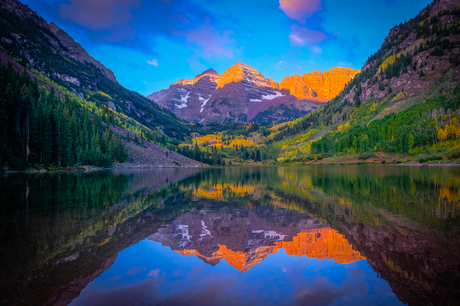

Class 4
North Maroon Peak is a 14,014-foot peak located in the Elk Mountains of central Colorado. The trail to the summit is a difficult and technical climb that requires scrambling and exposure. Hikers are rewarded with stunning views of the surrounding peaks and valleys, including the nearby Maroon Bells.
Capitol Peak

Class 4
Capitol Peak is a 14,137-foot peak located in the Elk Mountains of central Colorado. The trail to the summit is a difficult and technical climb that requires scrambling and exposure. Hikers are rewarded with stunning views of the surrounding peaks and valleys, including the iconic Knife Edge Ridge.
Snowmass Mountain

Class 3
Snowmass Mountain is a 14,092-foot peak located in the Elk Mountains of central Colorado. The trail to the summit is a challenging and technical climb that requires scrambling and exposure. Hikers are rewarded with breathtaking views of the surrounding peaks and valleys, including the nearby Maroon Bells.
Castle peak
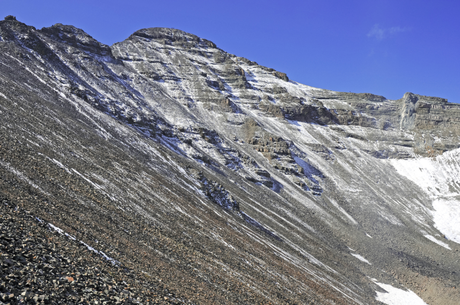

Class 2
Hiking Castle Peak in Colorado is a must-do for experienced climbers, offering a classic desert tower ascent and incredible views of the surrounding red rock formations. Standing at 400 feet, the summit requires technical rock climbing skills and proper safety gear, but the climb is well worth the effort.
Longs Peak

Class 3
Longs Peak is a 14,259-foot peak located in Rocky Mountain National Park in Colorado. The trail to the summit is a challenging and technical climb that requires scrambling and exposure. Hikers are rewarded with stunning views of the surrounding peaks and valleys, including the iconic Diamond face of the mountain.
Mount Evans

Class 2
Mount Evans is a 14,271-foot peak located in the Front Range of central Colorado. The summit is accessible by car, but hikers can also reach it by following a challenging and scenic trail. Hikers are rewarded with stunning views of the surrounding mountains and valleys from the summit.
Mount Bierstadt

Class 2
Mount Bierstadt is a 14,060-foot peak located in the Front Range of central Colorado. The trail to the summit is a popular and relatively easy hike, making it a great choice for beginner and intermediate hikers. Hikers are rewarded with stunning views of the surrounding mountains and valleys from the summit.
Pikes Peak

Class 1
Pikes Peak is a 14,115-foot peak located in the Front Range of Colorado. The summit is accessible by car or cog railway, but hikers can also reach it by following a challenging and scenic trail. Hikers are rewarded with stunning views of the surrounding mountains and valleys from the summit.
Mount Wilson

Class 3
Mount Wilson is a 14,246-foot peak located in the San Juan Mountains of southwestern Colorado. The trail to the summit is a challenging and technical climb that requires scrambling and exposure. Hikers are rewarded with breathtaking views of the surrounding peaks and valleys, including the nearby Wilson Peak.
El Diente Peak

Class 3
El Diente Peak is a 14,159-foot peak located in the San Juan Mountains of southwestern Colorado. The trail to the summit is a challenging and technical climb that requires scrambling and exposure. Hikers are rewarded with stunning views of the surrounding peaks and valleys, including the nearby Mount Wilson.
Mount Sneffels
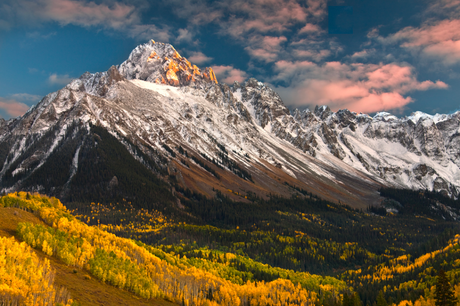

Class 3
Mount Sneffels is a 14,158-foot peak located in the San Juan Mountains of southwestern Colorado. The trail to the summit is a challenging and technical climb that requires scrambling and exposure. Hikers are rewarded with stunning views of the surrounding peaks and valleys, including the iconic Blue Lakes.
Wilson Peak

Class 3
Wilson Peak is a 14,023-foot peak located in the San Juan Mountains of southwestern Colorado. The trail to the summit is a challenging and technical climb that requires scrambling and exposure. Hikers are rewarded with breathtaking views of the surrounding peaks and valleys, including the nearby Mount Wilson and El Diente Peak.
Windom Peak

Class 2
Windom Peak is a 14,082-foot peak located in the San Juan Mountains of southwestern Colorado. The trail to the summit is a challenging and technical climb that requires scrambling and exposure. Hikers are rewarded with stunning views of the surrounding peaks and valleys, including the nearby Sunlight Peak and Eolus.
Handies Peak

Class 1
Handies Peak is a 14,048-foot peak located in the San Juan Mountains of southwestern Colorado. The trail to the summit is a moderate climb that offers stunning views of the surrounding peaks and valleys. Hikers can also explore the nearby American Basin, which is known for its wildflowers and alpine scenery.
Redcloud Peak

Class 2
Hiking Redcloud Peak in Colorado is a challenging but enjoyable hike, featuring stunning alpine meadows, high-altitude terrain, and breathtaking views of the San Juan Mountains. Standing at 14,034 feet, Redcloud Peak is one of Colorado’s fourteeners and a popular destination for experienced hikers seeking a challenging climb.
Sunshine Peak

Class 2
Hiking Sunshine Peak in Colorado is a scenic and rewarding experience, offering sweeping panoramic views of the San Juan Mountains and challenging high-altitude terrain. Standing at 14,001 feet, this fourteener can be accessed via the popular Redcloud Peak trailhead, making it a great addition to any high-altitude hiking itinerary.
Uncompahgre Peak
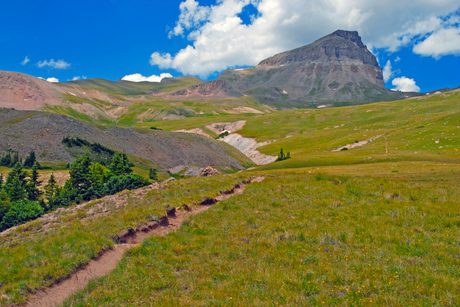

Class 2
Hiking Uncompahgre Peak in Colorado is a challenging yet stunning experience, featuring high-altitude terrain and spectacular views of the San Juan Mountains. Standing at 14,309 feet, this fourteener can be accessed via the Nellie Creek trailhead, and rewards hikers with breathtaking views from the summit.
Wetterhorn Peak

Class 3
Hiking Wetterhorn Peak in Colorado is a challenging and exhilarating climb, featuring steep switchbacks, exposed ridges, and breathtaking panoramic views of the surrounding mountain ranges. Standing at 14,015 feet, this fourteener can be accessed via the Matterhorn Creek trailhead and requires technical rock climbing skills to reach the summit.
San Luis Peak

Class 1
Hiking San Luis Peak in Colorado is a scenic and challenging experience, featuring high-altitude terrain and breathtaking views of the surrounding San Juan Mountains. Standing at 14,014 feet, this fourteener can be accessed via the Stewart Creek trailhead and rewards hikers with sweeping views from the summit.
Kit Carson Peak

Class 3
Hiking Kit Carson Peak in Colorado is a challenging and rewarding experience, featuring high-altitude terrain and stunning views of the Sangre de Cristo Mountains. Standing at 14,165 feet, this fourteener can be accessed via the Challenger Point trailhead and requires technical climbing skills and proper gear to reach the summit.
Challenger Point

Class 2
Hiking Challenger Point in Colorado is a thrilling and demanding experience, featuring high-altitude terrain and scenic views of the Sangre de Cristo Mountains. Standing at 14,081 feet, this fourteener can be accessed via the Willow Creek trailhead and requires experienced hikers to navigate steep switchbacks and technical terrain.
Humboldt Peak

Class 2
Hiking Humboldt Peak in Colorado is a challenging but rewarding experience, featuring steep switchbacks and stunning views of the surrounding Sangre de Cristo Mountains. Standing at 14,064 feet, this fourteener can be accessed via the South Colony Lakes trailhead and offers a great opportunity for experienced hikers seeking a challenging climb.
Crestone Peak

Class 3
Hiking Crestone Peak in Colorado is a challenging and exciting experience, featuring high-altitude terrain and breathtaking views of the Sangre de Cristo Mountains. Standing at 14,294 feet, this fourteener can be accessed via the South Colony Lakes trailhead and requires technical climbing skills and proper gear to reach the summit.
Crestone Needle

Class 4
Hiking Crestone Needle in Colorado is a challenging and rewarding experience, featuring steep terrain and breathtaking views of the Sangre de Cristo Mountains. Standing at 14,197 feet, this fourteener can be accessed via the South Colony Lakes trailhead and requires technical climbing skills and proper gear to reach the summit.
Mount Lindsey

Class 3
Hiking Mount Lindsey in Colorado is a challenging and scenic experience, featuring high-altitude terrain and stunning views of the Sangre de Cristo Mountains. Standing at 14,042 feet, this fourteener can be accessed via the Huerfano trailhead and requires experienced hikers to navigate steep switchbacks and rocky terrain.
Ellingwood Point

Class 2
Hiking Ellingwood Point in Colorado is a thrilling and challenging experience, featuring high-altitude terrain and breathtaking views of the surrounding Sangre de Cristo Mountains. Standing at 14,042 feet, this fourteener can be accessed via the Lake Como trailhead and requires experienced hikers to navigate steep switchbacks and rocky terrain to reach the summit.
Blanca Peak

Class 2
Hiking Blanca Peak in Colorado is a challenging but rewarding experience, featuring high-altitude terrain and stunning views of the Sangre de Cristo Mountains. Standing at 14,345 feet, this fourteener can be accessed via the Lake Como trailhead and requires technical climbing skills and proper gear to reach the summit.
Little Bear Peak
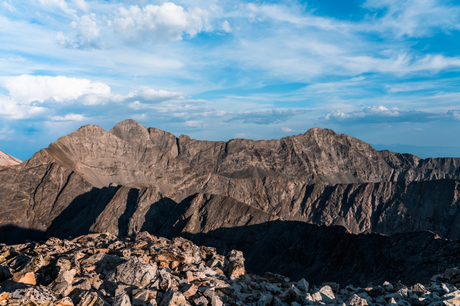

Class 4
Hiking Little Bear Peak in Colorado is a thrilling and challenging experience, featuring steep terrain and stunning views of the Sangre de Cristo Mountains. Standing at 14,037 feet, this fourteener can be accessed via the Lake Como trailhead and requires experienced hikers to navigate technical rock climbing, steep couloirs, and loose scree to reach the summit.
Culebra Peak

Class 2
Hiking Culebra Peak in Colorado is a scenic and challenging experience, featuring high-altitude terrain and breathtaking views of the surrounding Sangre de Cristo Mountains. Standing at 14,047 feet, this fourteener can be accessed via the Cielo Vista Ranch and requires a fee and a reservation to access the peak. The trail offers a unique opportunity to hike on private property and features a challenging but rewarding ascent to the summit.
Mount Shavano

Class 2
Hiking Mount Shavano in Colorado is a challenging and rewarding experience, featuring high-altitude terrain and stunning views of the surrounding Sawatch Range. Standing at 14,229 feet, this fourteener can be accessed via the Shavano/Tabeguache trailhead and requires experienced hikers to navigate steep switchbacks and rocky terrain to reach the summit.
Tabeguache Peak

Class 2
Hiking Tabeguache Peak in Colorado is a challenging and rewarding experience, featuring high-altitude terrain and stunning views of the surrounding Sawatch Range. Standing at 14,155 feet, this fourteener can be accessed via the Shavano/Tabeguache trailhead and requires experienced hikers to navigate steep switchbacks and rocky terrain to reach the summit. The trail also offers the option to continue on to the nearby Mount Shavano for a longer hike.
Antero Peak

Class 2
Hiking Antero Peak in Colorado is a challenging and scenic experience, featuring high-altitude terrain and stunning views of the surrounding Sawatch Range. Standing at 14,276 feet, this fourteener can be accessed via the Browns Creek trailhead and requires experienced hikers to navigate steep switchbacks and rocky terrain to reach the summit.
Mount Sherman

Class 2
Hiking Mount Sherman in Colorado is a popular and accessible fourteener, offering hikers a moderately challenging route to the summit at 14,036 feet. Accessible via the Fourmile Creek trailhead, the hike features stunning views of the surrounding peaks and valleys, and is suitable for hikers of varying skill levels.
Quandary Peak
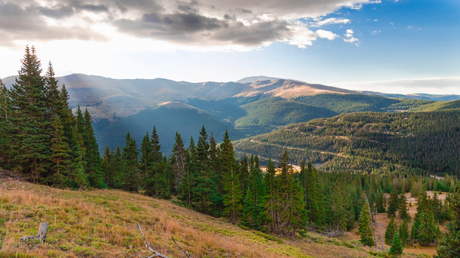

Class 1
Quandary Peak is a popular hiking trail located in Colorado, USA. The 14,265-foot peak offers stunning panoramic views of the surrounding mountains and valleys. The trail is moderately challenging and is recommended for experienced hikers, with an average round trip taking between 6-8 hours.
Mount Harvard

Class 2
The trail covers over 14 miles with an elevation gain of more than 4,000 feet. Hikers can enjoy stunning views of the Collegiate Peaks Wilderness and reach the summit at 14,421 feet, one of Colorado’s highest peaks.
Mount Yale

Class 2
Hiking Mount Yale in Colorado is a challenging yet rewarding experience. With a summit elevation of 14,196 feet, hikers will traverse through steep terrain, high altitude, and stunning views of the surrounding Collegiate Peaks.
Mount Columbia

Class 2
The trail is approximately 11 miles long with a total elevation gain of over 4,000 feet, offering breathtaking views of the surrounding mountains and valleys. The summit, standing at 14,073 feet, rewards hikers with sweeping panoramic views of the Collegiate Peaks Wilderness.
Planning Your 14er climbs
Planning is crucial when it comes to hiking the 14ers of Colorado. Before hitting the trails, it’s important to research the peak you plan to hike and the trail you will take. Information such as distance, elevation gain, and estimated hiking time can be found on HiiKER. It’s also a good idea to check the current weather conditions and forecast for the area, as well as any potential hazards, such as thunderstorms or high winds.
In addition to researching the trail, it’s important to have the proper gear and supplies. A sturdy pair of hiking shoes, plenty of water, a first-aid kit, and a map or GPS device are essential. Pack extra layers of clothing in case of changing weather conditions, and bring high-energy snacks or a packed lunch for the trail. It’s also important to pack for safety and be prepared for emergency situations. A flashlight, whistle, and signaling device can come in handy in case of an emergency.
Finally, it’s important to be aware of and follow Leave No Trace principles. This means packing out all of your trash, staying on designated trails, and respecting the wilderness and wildlife. By following these principles, you’ll help preserve the natural beauty of the 14ers for future generations to enjoy.
What to Bring
When hiking the 14ers of Colorado, it’s important to bring the right gear and supplies to ensure a safe and enjoyable experience. Here’s a list of essential items to bring on your hike:
- Sturdy hiking shoes – Good quality hiking shoes will provide proper support and help prevent injuries.
- Plenty of water – Dehydration is a common problem, so it’s important to stay hydrated by bringing at least 2 liters of water per person.
- First-aid kit – Include basic items such as bandages, pain relievers, and any personal medications.
- Paper map and HiiKER app – Knowing your location and the trail ahead can be critical in emergency situations. While apps like HiiKER are incredibly helpful in knowing your location and for planning your journey ahead, you should always bring a paper map and compass with you – and know how to use them.
- Extra layers of clothing – The weather in the mountains can change quickly, so it’s important to be prepared for varying temperatures.
- High-energy snacks – Snacks such as energy bars or trail mix can help keep you fueled during your hike.
- Packed lunch – If you plan on spending the whole day on the trail, it’s a good idea to bring a packed lunch to keep you energized.
- Headlamp or flashlight – This will come in handy in case of an emergency or if you need to continue your hike in low light.
- Whistle – A loud whistle can be used to signal for help in emergency situations.
- Trash bags – Pack it in, pack it out – leave no trace behind.
- By bringing these essential items, you’ll be prepared for anything the trail may throw at you, and you’ll have a safe and enjoyable experience hiking the 14ers of Colorado.
Climbing the Colorado 14er peaks
Hiking the 14ers of Colorado can be a challenging and rewarding experience. The climb to the summit of one of these peaks can take anywhere from a few hours to a full day, depending on the trail and your fitness level. It’s important to pace yourself and listen to your body – if you feel tired, take a break, and if you’re experiencing altitude sickness, descend to a lower elevation.
Here are some further ways to prevent altitude sickness:
- Acclimatize: Spend time at higher elevations to allow your body to adjust to the altitude gradually. Don’t try to climb too high too quickly.
- Stay hydrated: Drink plenty of fluids, as dehydration can make altitude sickness symptoms worse.
- Avoid alcohol and caffeine: Both can dehydrate the body and make altitude sickness symptoms worse.
- Eat a balanced diet: Eating a diet rich in carbohydrates can help provide the energy your body needs to climb at high elevations.
- Consider medication: Certain medications, such as acetazolamide, can help prevent altitude sickness by promoting breathing and increasing oxygenation in the blood.
- Take it slow: Don’t rush the climb. Take frequent breaks to rest and allow your body to adjust to the altitude.
- Descend if necessary: If altitude sickness symptoms become severe, descend to a lower elevation immediately. Don’t continue climbing until the symptoms have completely disappeared.
The trails to the summits of the 14ers vary in difficulty, but most involve steep inclines and rocky terrain. Be prepared for loose rock, steep drop-offs, and exposure to the elements. It’s important to be aware of your footing, especially when the trail is wet or covered in snow.
The scenery along the way is stunning, with breathtaking views of the surrounding mountains and valleys. Keep an eye out for wildlife, as you may see mountain goats, marmots, and other alpine animals.
When you reach the summit, take a moment to celebrate your accomplishment, and enjoy the panoramic views. Remember to take plenty of photos and make memories that will last a lifetime. And when it’s time to descend, be careful and stay on the designated trail to avoid erosion and preserve the natural beauty of the 14ers.
Other useful links
- https://www.14ers.com/
- https://www.colorado.com/articles/what-are-14ers
- https://www.voc.org/
- https://www.rmfi.org/
